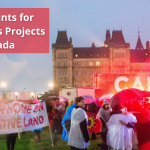
The Government of Canada will provide funding to eligible not-for-profit organizations, including registered charities and other qualified donees under the Income Tax Act, for projects that increase their capacity to undertake charitable or similar activities. The program is intended to help these organizations build their ability to deliver on the mandate they have been entrusted with by Canadians. The Participant Funding Program will provide funding to successful applicants in the form of a contribution agreement. The amount of funding available to an organization will be based on its size and scope, as well as the nature and complexity of the project for which it is applying.
Organizations that are interested in applying for funding under the program must submit an Expression of Interest through Grants and Contributions Online Services. A committee will review all submissions and invite eligible organizations to submit a full application. Applications will be assessed against criteria that include:
– The extent to which the proposed project responds to a demonstrated need;
– The degree to which the proposed project is likely to lead to increased capacity within the organization;
– The clarity, feasibility, and appropriateness of the project plan;
– The degree to which the proposed project represents value for money.
The program will be delivered through a competitive process, and funding will be awarded to those organizations that demonstrate the strongest ability to deliver on their proposed projects.
Read More: Shelter Enhancement Program
Organizations that are interested in applying for funding under the Participant Funding Program are encouraged to contact their nearest Regional Development Agency. If an organization is successful in its application, it will be required to enter into a contribution agreement with the Government of Canada. The contribution agreement will set out the terms and conditions of the funding, including any reporting requirements. The program is currently open to organizations across Canada. For more information, please visit the Participant Funding Program website.
What Is a Participation Funding Program?
The Participant Funding Program (PFP) is administered by the Canada Energy Regulator (CER) to assist the public – particularly Indigenous peoples of Canada and Indigenous organizations – in participating in public hearings held under section 52 of subsection 241(3) of the Canadian Energy Regulator (CER) Act and any steps leading up to those hearings.
Read More: Canadian Government Grants for Disabled Homeowners: Nearly 100 Grants for Home Renovations
Whether it’s a project-specific assessment by the Agency or a review panel, a regional assessment, or a strategy assessment, the Participant Funding Program strives to enhance public engagement and Indigenous consultation during an assessment. It achieves so by giving financing at important points in the evaluation process, such as when follow-up programs are implemented. Participant funding helps to ensure a fair and balanced evaluation procedure. This improves the quality and trustworthiness of federal assessments.
Who Is Eligible to Participate?
The Agency contacts Indigenous communities that may be impacted by a project ahead of time to inform them of chances to participate in consultation activities and receive financial support for doing so. Individuals, non-profit groups, and Indigenous communities and organizations may apply to participate in the evaluation. Applicants must show how their participation will add value to the assessment and provide relevant knowledge or experience. They must also meet one or more of the following requirements:
· Have an interest in the potential implications of a project on Treaty lands, settlement lands, or traditional territories, as well as related claims and rights.
· Have a direct local interest in the project or regional/strategic assessment, such as living in the project area or owning property there;
· Have community or Indigenous information that is important to the impact or regional/strategic evaluation;
· Have access to professional information about the project’s expected effects.
Opportunities for Participation
This funding initiative promotes possibilities for public participation and Indigenous consultation on the Agency’s website. Only submissions for current participation activities are considered by the Agency.
Public Participation
Participation of the public in federal impact assessments enables an open, balanced process that improves the quality and credibility of the project’s review. Early in the impact assessment process, community and Indigenous knowledge regarding a project’s physical site can assist in identifying and addressing the potential impacts of a designated project.
The Impact Assessment Act recognizes this and demands meaningful public participation throughout the assessment process. Prior to the start of the formal impact assessment, the public is invited to participate. Public involvement at the planning phase of a project establishes defined objectives for public involvement and allows issues to be recognized and communicated to the project proponent and officials from the start. The Planning phase also includes the creation of a Public Involvement Plan, which incorporates public feedback and outlines public participation objectives, engagement opportunities at each stage of the process, and engagement strategies that are appropriate for the community. This gives the public assurance about how and when they will engage within the time frames established by the Impact Assessment Agency (the Agency).
The Agency or, if applicable, a Review Panel will involve the public in ways that accord with the Public Participation Plan’s objectives throughout the impact assessment process. The public’s comments will be captured in an Impact Assessment Report and will become part of the public record. This information will be examined by the Minister of the Environment and Climate Change or Cabinet when making a public interest judgment on the project, as required by law. Under the Impact Assessment Act, there are several ways to engage in government impact assessments.
How to Apply?
For each source of financing, download and complete one of the application forms below. Check the project’s home page on the Canadian Impact Assessment Registry for the right type of financing.
To be considered for participant funding, you must submit your application by the deadline listed in the table of Current funding options.
Canada Energy Regulator Participant Funding Program Suite 210, 517 Tenth Avenue SW Calgary, Alberta T2R 0A8
fax: 1-877-288-8803
Email: [email protected]
mail or courier: Canada Energy Regulator Participant Funding Program Suite 210, 517 Tenth Avenue SW Calgary, Alberta T2R 0A8
What Costs Are Eligible?
The contribution agreement, in general, allows for eligible costs spent from the time the company submitted the project application with the CER until the hearing record closes. Recipients should also be aware that there are many unknowns around the procedure when applying for funding, such as the timing of process steps and the location of any oral components. Delays from the original hearing schedule are not uncommon, so recipients should budget accordingly.
The following costs are eligible for funding, provided they relate to eligible activities, and enough rationale is provided in the PFP application form:
Other relevant expenditures essential for the proposed activity, such as meeting space rental and gathering, dissemination, translation, or acquisition of information resources, include legal fees, expert fees, travel expenses, honoraria, and ceremonial charges.
What Costs Are Ineligible?
There will be no financial assistance for costs that are not qualifying, such as:
1. Negotiations with the proponent concerns outside the CER’s authority are examples of activities that are unrelated to your participation in the CER hearing or environmental assessment.
2. Duplicate services, studies, or written materials already prepared by you, the CER, the proponent, or other public sources.
3. Costs not directly incurred, such as the recipient’s need to pay himself, lost revenue, the applicant’s facility or rental equipment, and a general administration fee.
4. Duplicate payments, such as costs repaid by other sources and individuals who are already paid for their time.
5. Rent, overhead, general operations, and salaries are all examples of normal operational expenses.6. Construction, refurbishment, and maintenance costs are all included in capital expenditures.
How Much Should I Expect to Get?
The amount a candidate can expect to get is determined by the following factors:
the funding envelope announced for the project divided by the number of eligible PFP applicants, the applicable funding maximum, (group or individual) PFP’s annual budget, the eligibility, and reasonableness of the costs requested in your PFP application, the funding envelope announced for the project divided by the number of eligible PFP applicants the funding envelope announced for the project divided by the number of eligible PFP applicants (approved by Parliament).
PFP is not designed to pay all costs involved with participation in the hearing or environmental assessment because funding is limited. Eligible Recipients are encouraged to work together and seek additional funding sources. You might want to reach out to other Intervenors to see if you can split the costs.














Leave a Reply